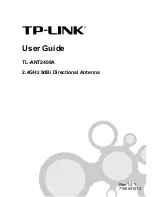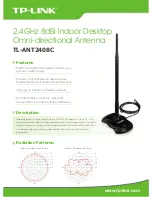
RMANT1450 / RMANT1450BF /
RMANT1450BFV /RMANT1450BR
Amplifi ed Flat Multi-Directional
Indoor Antenna
Antena multidireccional plana amplifi cada para interiores
User’s Guide
Guía del Usuario
Congratulations on your purchase of the Amplifi ed Flat Multi-Directional Indoor Antenna.
With this contemporary antenna, rabbit ears are a thing of the past. This sleek, attractive
antenna features the most advanced technology, including a patented engineering design that
provides excellent reception for both analog and digital TV broadcasts.
Multi-Directional Antennas
A multi-directional antenna is able to receive signals from any direction. Useful for both
analog and digital reception, the antenna looks great, facilitates optimal reception, and
requires very little space. The patented multi-directional technology ensures that the
antenna does not need to be adjusted according to the location of the transmitting signal.
FCC Statement:
This device complies with part 15 of the FCC Rules. Operation is subject to the following two conditions: (1) This device
may not cause harmful interference, and (2) this device must accept any interference received, including interference that
may cause undesired operation.
Note: This equipment has been tested and found to comply with the limits for a Class B digital device, pursuant to part 15
of the FCC Rules. These limits are designed to provide reasonable protection against harmful interference in a residential
installation. This equipment generates, uses and can radiate radio frequency energy and, if not installed and used in
accordance with the instructions, may cause harmful interference to radio communications. However, there is no guarantee
that interference will not occur in a particular installation. If this equipment does cause harmful interference to radio or
television reception, which can be determined by turning the equipment off and on, the user is encouraged to try to correct
the interference by one or more of the following measures:
•
Reorient or relocate the receiving antenna.
•
Increase the separation between the equipment and receiver.
•
Connect the equipment into an outlet on a circuit different from that to which the receiver is connected.
•
Consult the dealer or an experienced radio/TV technician for help.
Caution: Any Changes or modifi cations not expressly approved by the party responsible for compliance could void the user’s
authority to operate this equipment.
Industry Canada Regulatory Information
CAN ICES-3 (B)/NMB-3 (B)
Avis d’Industrie Canada
CAN ICES-3 (B)/NMB-3 (B)

























